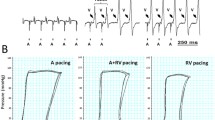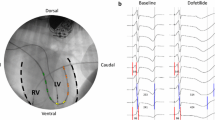Abstract
Introduction Pacing site is known to influence the contractile state of the ventricle. Non-physiologic pacing sites such as the right ventricular apex (RVA) or left ventricular freewall (LVFW) have been shown to decrease the contractile state of normal myocardium, due to abnormal electrical propagation. The impact of pacing at these sites may alter mechanical restitution (MR), a fundamental cardiac property involving the electro-mechanical regulation of contraction. This, in turn, may affect cardiac function. The present study was conducted to determine if pacing site alters the time constant of MR: τ. Methods and results Anesthetized canines (n = 6) were acutely paced at four sites: right atrium (RA), RVA, right ventricular septum (RVS), and LVFW. MR data was captured by the S1–S2 pacing protocol and used to create MR curves, generating a restitution time constant, τ, at each site. No significant difference in τ was found between pacing sites. A linear regression analysis of MR curves revealed that there was no significant difference in slope between pacing sites. Conclusion Although pacing site has been found to influence the contractile state of the ventricle, this is the first known study to demonstrate no change in τ in an in vivo preparation. This suggests that alteration of electro-mechanical coupling described by MR is not sufficiently robust to provide insight into pacing site and cardiac function in healthy hearts.






Similar content being viewed by others
References
Ahlberg S, Ripplinger C, Skadsberg N, Iaizzo P, Mulligan L. Effects of pacing rate on mechanical restitution within the in vivo canine heart: study of the force-frequency relationship. J Cardiovasc Electrophysiol 2007;18:1–6.
Anderson P, Manring A, Serwer G, Benson D, Edwards S, Armstrong B, Sterba R, Floyd R. The force–interval relationship of the left ventricle. Circulation 1979;60:334–48.
Braunwald E, Zipes D, Libby P. Heart disease. A textbook of cardiovascular medicine. 6th ed. Philadelphia: W B Saunders Co.; 2001.
Burkhoff D, Sagawa K. Influence of pacing site on canine left ventricular force-interval relationship. Am J Physiol 1986;250:H414–8.
Burkhoff D, Yue D, Franz M, Hunter W, Sagawa K. Mechanical restitution of isolated perfused canine left ventricles. Am J Physiol 1984;246:565–81.
Cooper I, Fry C. Mechanical restitution in isolated mammalian myocardium: species differences and underlying mechanisms. J Mol Cell Cardiol 1990;22:439–52.
Franz M, Schaefer J, Schottler M, Seed W, Noble I. Electrical and mechanical restitution of the human heart at different rates of stimulation. Circ Res 1983;53:815–22.
Freeman G, Colston J. Evaluation of left ventricular mechanical restitution in closed-chest dogs based on single-beat elastance. Circ Res 1990;67:1437–45.
Higgins C, Vatner S, Franklin D, Braunwald E. Extent of regulation of the heart’s contractile state in the conscious dog by alteration in the frequency of contraction. J Clin Invest 1973;52:1187–94.
Hoit B, Kandambi V, Tramuta D, Ball N, Kranias E, Walsh R. Influence of sarcoplasmic reticulum calcium loading on mechanical and relaxation restitution. Am J Physiol Heart Circ Physiol 2000;278:H958–63.
Karpawich P. Chronic right ventricular pacing and cardiac performance: the pediatric perspective. PACE 2004;27:844–9.
Kass D, Maughan W, Guo Z, Kono A, Sunagawa K, Sagawa K. Comparative influence of load versus inotropic states on indexes of ventricular contractility: experimental and theoretical analysis based on pressire–volume relationships. Circulation 1987;76:1422–36.
Kerchhoffs R, Faris O, Bovendeerd P, Prinzen F, Smits K, McVeigh E, Arts T. Timing of depolarization and contraction in the paced canine left ventricle: model and experiment. J Cardiovasc Electrophysiol 2003;14:S188–95.
Laske T, Skadsberg N, Hill A, Klein G, Iaizzo P. Excitation of the intrinsic conduction system through his and interventricular septal pacing. PACE 2006;29:397–405.
Lee M, Dae M, Langberg J, Griffin J, Chin M, Finkbeiner W, O’Connell J, Botvinick E, Scheinman M, Rosenqvist M. Effects of long-term right ventricular apical pacing on left ventricular perfusion, innervation, function and histology. JACC 1994;24:225–32.
Liu C, Ting C, Lawrence W, Maughan W, Chang M, Kass D. Diminished contractile response to increased heart rate in intact human left ventricular hypertrophy: systolic versus diastolic determinants. Circulation 1993;88:1893–906.
Manolis AS. The deleterious consequences of right ventricular apical pacing: time to seek alternate site pacing. PACE 2006;29:298–315.
Mond H, Gammage M. Selective site pacing: the future of cardiac pacing? PACE 2004;27:835–6.
Nahlawi M, Waligora M, Spies S, Bonow R, Kadish A, Goldberger J. Left ventricular function during and after right ventricular pacing. J Am College Cardiol 2004;44:1883–8.
Noble M, Wyler J, Milne E, Trenchard D, Guz A. Effect of changes in heart rate on left ventricular performance in conscious dogs. Circ Res 1969;24:285–95.
Res JCJ, Bokern MJJA, Vos DHS. Characteristics of bifocal pacing: right ventricular apex versus outflow tract. An interim analysis. PACE 2005;28:S36–8.
Ritchie R, Wuttke R, Hii J, Jarrett R, Carey A, Horowitz J. The force interval relationship of the left ventricle: a quantitative description in patients with ischemic heart disease. J Cardiac Failure 1995;1:273–84.
Schwaab B, Frohlig G, Alexander C, Kindermann M, Hellwig N, Schwerdt H, Kirsch C-M, Schieffer H. Influence of right ventricular stimulation site on left ventricular function in atrial synchronous ventricular pacing. JACC 1999;33:317–23.
Seed W. Interval–force processes in the intact animal and human heart. In: Noble M, Seed W, editors. The interval–force relationship of the heart: Bowditch revisited. Cambridge: Cambridge University Press; 1992. p. 317–354.
Tse H-F, Yu C, Wong K-K, Tsang V, Leung Y-L, Ho W-Y, Lau C-P. Functional abnormalities in patients with permanent right ventricular pacing. The effect of sites of electrical stimulation. J Am College Cardiol 2002;40:1451–8.
Vernooy K, Verbeek X, Peschar M, Prinzen F. Relation between abnormal ventricular impulse conduction and heart failure. J Interven Cardiol 2003;16:557–62.
Wier W, Yue D. Intracellular calcium transients underlying the short-term force–interval relationship in ferret ventricular myocardium. J Physiol Lond 1986;376:507–30.
Wilkoff B, Cook J, Epstein A, Greene H, Hallstrom A, Hsia H, Kutalek A, Sharma A. Dual-chamber pacing or ventricular backup pacing in patients with an implantable defibrillator. The dual chamber and VVI implantable defibrillator (DAVID) trial. J Am Med Assoc 2002;288:3115–23.
Winslow R, Scollan D, Holmes A, Yung C, Zhang J, Jafri M. Electrophysiological modeling of cardiac ventricular function: from cell to organ. Annu Rev Biomed Eng 2000;2:119–55.
Yates R, Goodman D. Probability and stochastic processes – a friendly introduction for electrical and computer engineers. John Wiley & Sons, Inc.; 2005.
Yue D, Burkhoff D, Franz M, Hunter W, Sagawa K. Postextrasystolic potentiation of the isolated canine left ventricule: relationship to mechanical restitution. Circ Res 1985;56:340–50.
Acknowledgments
This research was funded by Medtronic, Inc. and the Biomedical Engineering Institute at the University of Minnesota.
Author information
Authors and Affiliations
Corresponding author
Rights and permissions
About this article
Cite this article
Ahlberg, S.E., Grenz, N.A., Ewert, D.L. et al. Effect of Pacing Site on Systolic Mechanical Restitution Curves in the In Vivo Canine Model. Cardiovasc Eng 7, 89–96 (2007). https://doi.org/10.1007/s10558-007-9033-9
Published:
Issue Date:
DOI: https://doi.org/10.1007/s10558-007-9033-9




